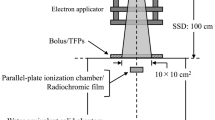Abstract
Purpose
The dose changes in the buildup region and beam attenuation by a carbon fiber tabletop were investigated for 6-and 18-MV photon beams.
Materials and methods
Measurements were performed for 2 × 2 cm to 40 × 40 cm field sizes. The surface dose and percentage depth doses (PDD) were measured by a Markus parallel plate chamber. Attenuation measurements were made at the cylindrical phantom for 180° rotation of the beam.
Results
A carbon fiber tabletop increases the surface dose from 7.5% to 63.0% and from 4% to 43% for small fields at 6 and 18 MV, respectively. The increase was nearly fivefold for the 10 × 10 cm field and nearly twofold for the 40 × 40 cm field. Beam attenuation of the tabletop varies from 3.0% to 5.6% for 180° and 120° gantry angles for 6 MV.
Conclusion
The carbon fiber tabletop significantly decreases the skin-sparing effect. The dosimetric effect of the tabletop may be higher, especially for the intensity-modulated radiation therapy depending on the beam orientation. Attenuation should be considered and corrected such as any material under the patient at the treatment planning stage.
Similar content being viewed by others
References
Kim S, Liu CR, Zhu TC, Palta JR. Photon beam skin dose analyses for different clinical setups. Med Phys 1998;25:860–866.
Cheung T, Butson MJ, Yu PK. Evaluation of build-up dose from 6 MV X-rays under pelvic and abdominal patient immobilization devices. Radiat Meas 2002;35:235–238.
Nilsson B. Electron contamination from different materials in high energy photon beams. Phys Med Biol 1985;30:139–151.
Williams P, Warwick R, Dyson M, Bannister L. Gray’s anatomy. 37th edition. New York: Churchill Livingstone, 1989.
Butson MJ, Mathur JN, Metcalfe PE. Skin dose from radiotherapy X-ray beams: the influence of energy. Australas Radiol 1997;41:148–150.
Gerbi BJ, Khan FM. Measurements of dose in the build-up region on using fixed-separation plane-parallel ionization chamber. Med Phys 1990;17:17–26.
Gerbi BJ. The response characteristics of a newly designed plane-parallel ionization chamber in high-energy photon and electron beams. Med Phys 1993;20:1411–1415.
Jornet N, Ribas M, Eudaldo T. In vivo dosimetry: intercomparison between p-type based and n-type based diodes for the 16–25 MV energy range. Med Phys 2000;27:1287–1293.
Kron T, Elliot A, Wong T, Showell G, Clubb B, Metcalfe P. X-ray surface dose measurements using TLD extrapolation. Med Phys 1993;20:703–711.
Devic S, Seuntjens J, Abdel-Rahman W, Evans M, Olivares M, Podgorsak EB. Accurate skin dose measurements using radiochromic film in clinical applications. Med Phys 2006;33:1116–1124.
Butson MJ, Rosenfeld A, Mathur JN, Carolan M, Wong TPY, Metcalfe PE. A new radiotherapy surface dose detector: the MOSFET. Med Phys 1996;23:655–658.
De Ost B, Vanregemorter J, Schaeken B, Van den Weyngaert D. The effect of carbon fiber inserts on the build-up and attenuation of high energy photon beams. Radiother Oncol 1997;45:275–277.
Viera SC, Kaatee RSC, Dirkx MLP, Heijmen BJM. Two-dimensional measurement of photon beam attenuation by the treatment couch and immobilization devices using an electronic portal imaging device. Med Phys 2003;30:2981–2987.
Poppe B, Chofor N, Rühmann A, Kunth W, Djouguela A. The effect of a carbon-fiber couch on the depth-dose curves and transmission properties for megavoltage photon beams. Strahlen Oncol 2006;183:43–48.
McCormack S, Diffey J, Morgan A. The effect of gantry angle on megavoltage photon beam attenuation by a carbon fiber couch insert. Med Phys 2005;32:483–487.
Gerbi BJ, Khan FM. The polarity effect for commercially available plane parallel ionization chambers. Med Phys 1987;14:210–215.
Mellenberg DE. Determination of build-up region over-response corrections for a Markus-type chamber. Med Phys 1990;17:1041–1044.
Spezi E, Ferri A. Dosimetric characteristics of the Siemens IGRT carbon fiber tabletop. Med Dosim 2007;32:295–298
Meara SJP, Langmack KA. An investigation into the use of carbon fiber for megavoltage radiotherapy applications. Phys Med Biol 1998;43:1359–1366.
Higgins DM, Whitehurst P, Morgan AM. The effect of carbon fiber couch inserts on surface dose with beam size variation. Med Dosim 2001;26:251–254.
Author information
Authors and Affiliations
Corresponding author
About this article
Cite this article
Meydanci, T.P., Kemikler, G. Effect of a carbon fiber tabletop on the surface dose and attenuation for high-energy photon beams. Radiat Med 26, 539–544 (2008). https://doi.org/10.1007/s11604-008-0271-6
Received:
Accepted:
Published:
Issue Date:
DOI: https://doi.org/10.1007/s11604-008-0271-6




